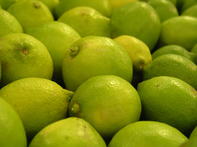Limes thrive in tropical and subtropical conditions. It is believed to have originated in Southeast Asia - around northern India, adjoining parts of Myanmar, Malaysia and Indonesia.

During the 10th century, Arab traders brought lime trees back from their journeys to the East and introduced them into Egypt and northern Africa. Whereas Arabian Moors took the fruit to Europe around the 13th century.
Limes are believed to have developed out of many different kinds of hybrids, so the general trend is for citrus with green flesh to be called limes. Different varieties, in effect, are all genetically distinct.
Limes vs Lemons
Limes are round and have a green colour in comparison with lemons, which are usually oval-shaped with a bright yellow colour. Limes are also generally smaller than lemons.
Both fruits are acidic and sour, but limes tend to have a more bitter flavour. Sweet and sour limes exist. The sweet limes lack the citric acid that gives sour limes their tart taste.
International Lime Production
Lime production is quite small in comparison with other citrus fruit. As reflected by Tridge, Spain is the biggest exporter, accounting for 18.8% of all lime exports in 2018, while Mexico took second place, accounting for 15.6% of all export volumes.
The United States is the biggest importer at 15.6% of all lime fruit imports in 2018, whereas Germany took second place, accounting for 11% of all imports. France and the Netherlands shared the third position, each accounting for 7.2% of all imports.
Production of Limes in South Africa
Lime production in South Africa is quite small, with only 82 ha being registered for exports in 2018. This is primarily because farmers can generate better income from other citrus crops.
Local Lime Production
Lime is produced throughout the country for home use or to supply local retailers. Hoedspruit, however, has more than half of the area registered for exports in 2018. Whereas the Boland has 12 ha and the Western Cape and Patensie account for 8 ha each. Seven hectares were also registered for exports in Groblersdal.
Lime Varieties
Bearss and Tahiti are the most planted varieties of lime in South Africa. The Bearrs variety is thought to have originated in California, from a seedling that developed out of Tahitian fruit. It was named after the owner, TJ Bearss, of the nursery where it developed.
The exact origin of the Tahiti lime is unknown. The name refers to the fact that the variety was introduced to California from Tahiti somewhere between 1850 and 1880. The variety is thought to have developed from a three-way hybrid, involving at least two different genera of citron, pummelo and a micro citrus species.
Lime Season
Although South African growers are able to harvest all year round, the season peaks from January to May.
Uses of Limes
Limes are rich in flavonoids, which has anti-cancer and antioxidant properties. The juice, for example, has been used in West Africa for many years to treat and prevent cholera. Limes are also rich in vitamins and minerals. It contains more than 30% of a grown-ups’ daily vitamin C requirements.
Due to its sour taste, limes are generally not eaten fresh. The juice and zest, however, is often used in cooking, while slices of lime are also a popular garnish for cocktails and other drinks.
To get the most juice out of limes, they should be juiced at room temperature. The white pith under the green skin has a bitter taste, so should be avoided when grating or slicing the lime to make zest.
For bulk or Limes export enquiries please use the enquiry link below.